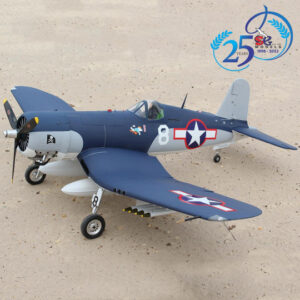The history of the F4U Corsair is a remarkable tale of innovation, resilience, and excellence in aviation. This legendary aircraft, designed and built by Vought, first took to the skies in 1940 and quickly established itself as one of the most formidable fighter planes of its era. Initially conceived to meet the United States Navy’s requirement for a high-speed carrier-based fighter, the F4U Corsair underwent several design iterations to optimize its performance and capabilities.

One of the most distinctive features of the F4U Corsair was its inverted gull-wing design, which was not merely an aesthetic choice but a functional innovation. This design allowed for the accommodation of the aircraft’s large propeller while maintaining shorter, more robust landing gear suitable for carrier operations. Furthermore, the bent wing configuration contributed to the Corsair’s exceptional aerodynamic efficiency, granting it superior speed and maneuverability.
Despite its promising design, the F4U Corsair faced significant challenges during its early operational period. The aircraft’s powerful Pratt & Whitney R-2800 Double Wasp engine, which provided unparalleled speed and climb rates, also generated considerable torque that made handling the Corsair a daunting task for inexperienced pilots. Additionally, the aircraft’s long nose impaired forward visibility, complicating carrier landings. These initial difficulties led the Navy to temporarily reassign the Corsair to land-based Marine Corps squadrons while improvements were made.
However, the Corsair’s potential could not be overlooked. As pilots gained experience and engineers introduced refinements, such as improved visibility and strengthened landing gear, the F4U Corsair gradually emerged as a dominant force in the Pacific Theater during World War II. Its prowess in dogfights and ground-attack missions earned it the moniker “Whistling Death” from the Japanese, a testament to its fearsome reputation. The Corsair’s ability to carry a substantial payload of bombs and rockets further enhanced its versatility, making it invaluable in both air-to-air combat and close air support roles.
As the war progressed, the F4U Corsair continued to evolve, with subsequent variants incorporating advanced radar systems, more powerful engines, and increased armament. The F4U-4 model, for example, featured a more potent engine and improved cockpit ergonomics, solidifying the Corsair’s status as one of the finest fighter aircraft of its time. Its impressive combat record, which included a high kill-to-loss ratio and numerous accolades for its pilots, underscored the aircraft’s exceptional capabilities.
In addition to its wartime achievements, the F4U Corsair left an indelible mark on post-war aviation. It remained in service with the U.S. Navy and Marine Corps during the Korean War, where it continued to demonstrate its effectiveness in various combat scenarios. Moreover, the Corsair saw service with several foreign air forces, further cementing its legacy as a versatile and enduring aircraft.
The history of the F4U Corsair is a testament to the ingenuity and determination of its designers, engineers, and pilots. From its challenging beginnings to its eventual triumphs, the Corsair’s journey exemplifies the relentless pursuit of excellence that defines the world of aviation. Today, the F4U Corsair is celebrated not only as a technological marvel but also as a symbol of courage and resilience, reminding us of the extraordinary feats that can be achieved through innovation and perseverance.